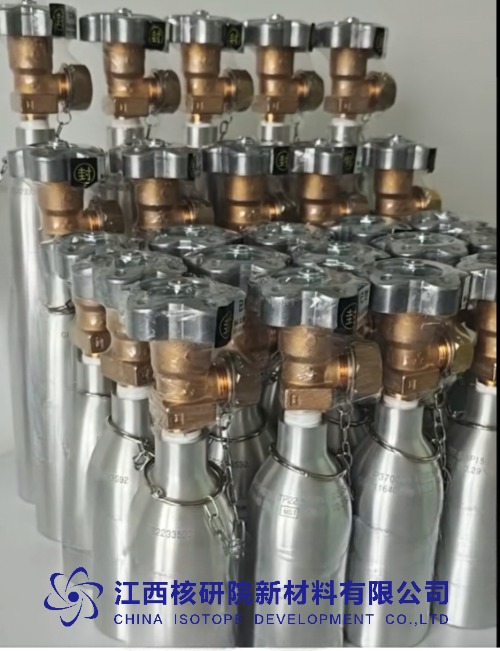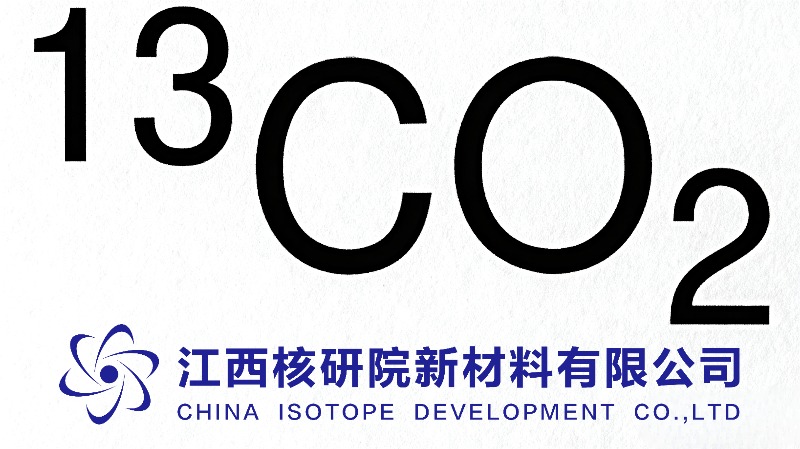High-Purity Carbon-13 Dioxide: The Core Material for Isotope Labeling Technology
BY Tao, Published Aug 9, 2025
High-purity carbon-13 dioxide (¹³CO₂) stands as a cornerstone in the realm of isotope labeling, a sophisticated technique that has transformed scientific research and industrial applications. This stable isotopic variant of carbon dioxide, enriched with the carbon-13 isotope, offers unparalleled precision in tracing molecular pathways, enabling breakthroughs in fields ranging from medical diagnostics to environmental science. With decades of expertise in nuclear chemistry and isotopic research, this article delves into the significance, production, applications, and technical specifications of high-purity ¹³CO₂, providing a comprehensive overview of its role as a critical material in modern science.
1. Understanding Carbon-13 and Its Importance
Carbon-13, a stable isotope of carbon, constitutes approximately 1.1% of naturally occurring carbon. Unlike its more abundant counterpart, carbon-12, carbon-13 possesses an additional neutron, resulting in a slightly higher atomic mass. This subtle difference allows scientists to track molecular behavior without introducing radioactivity, making ¹³CO₂ an ideal candidate for non-invasive studies. The high purity of ¹³CO₂—often exceeding 99% isotopic enrichment—ensures minimal interference from other isotopes, delivering precise and reliable results in analytical applications.
The unique nuclear properties of carbon-13, particularly its nuclear magnetic resonance (NMR) sensitivity, make it a powerful tool for structural elucidation and dynamic studies. By incorporating ¹³CO₂ into molecules, researchers can monitor metabolic processes, chemical reactions, and environmental cycles with exceptional accuracy. Its stability and compatibility with biological systems further enhance its utility, positioning ¹³CO₂ as a versatile material in both research and industry.
2. Applications of High-Purity Carbon-13 Dioxide
The versatility of high-purity ¹³CO₂ is reflected in its wide-ranging applications across multiple disciplines. Below are some of the primary areas where this isotope plays a pivotal role:
-
Medical Diagnostics and Research:
In medical research, ¹³CO₂ is a cornerstone of breath tests used to diagnose metabolic disorders, such as Helicobacter pylori infections and liver function abnormalities. Patients ingest a ¹³C-labeled substrate, which is metabolized to produce ¹³CO₂, detectable in exhaled breath via mass spectrometry or infrared spectroscopy. This non-invasive approach offers high sensitivity and specificity, making it a preferred diagnostic tool. -
Metabolic Studies:
In biochemistry, ¹³CO₂ is used to trace metabolic pathways in organisms. By introducing ¹³C-labeled compounds into biological systems, researchers can monitor carbon flux through metabolic networks, shedding light on processes like glucose metabolism, lipid synthesis, and protein turnover. This is particularly valuable in drug development and personalized medicine. -
Environmental Science:
¹³CO₂ is instrumental in studying carbon cycles and greenhouse gas dynamics. By tracking the isotopic composition of carbon dioxide in the atmosphere, soil, or oceans, scientists can quantify sources and sinks of carbon, contributing to climate change research and policy development. -
Chemical Synthesis and NMR Spectroscopy:
In organic chemistry, ¹³CO₂ serves as a building block for synthesizing labeled compounds used in NMR spectroscopy. The enhanced NMR signal of carbon-13 enables detailed structural analysis of complex molecules, aiding in drug discovery and material science. -
Industrial Applications:
High-purity ¹³CO₂ is used in the production of isotopically labeled materials for industrial purposes, such as calibration standards for analytical instruments and tracers in chemical engineering processes.
3. Production of High-Purity Carbon-13 Dioxide
Producing high-purity ¹³CO₂ is a complex process that demands precision and advanced technology. The journey begins with the enrichment of carbon-13, typically achieved through methods like cryogenic distillation, gas centrifugation, or laser-based separation. These techniques exploit the slight mass difference between carbon-12 and carbon-13 to isolate the heavier isotope.
Once enriched, the carbon-13 is converted into ¹³CO₂ through chemical reactions, often involving the oxidation of ¹³C-labeled precursors like methane or carbon monoxide. The resulting gas undergoes rigorous purification to remove impurities, such as water vapor, nitrogen, or trace amounts of other isotopes. Advanced purification techniques, including molecular sieves and gas chromatography, ensure that the final product meets stringent purity standards, typically exceeding 99.9% chemical purity and 99% isotopic enrichment.
The production process is tightly controlled to minimize contamination and ensure consistency. Facilities adhere to strict quality assurance protocols, with each batch undergoing spectroscopic analysis to verify isotopic composition and purity. This meticulous approach guarantees that ¹³CO₂ meets the exacting demands of scientific and industrial applications.
4. Product Specifications and Performance
High-purity ¹³CO₂ is a specialized product with precise technical specifications tailored to its intended use. Below is a detailed overview of its key parameters, performance characteristics, and usage considerations:
|
Parameter |
Specification |
|---|---|
|
Isotopic Enrichment |
≥99% (¹³C atom percentage) |
|
Chemical Purity |
≥99.9% (free from water, nitrogen, and other contaminants) |
|
Molecular Formula |
¹³CO₂ |
|
Molecular Weight |
45 g/mol |
|
Physical State |
Gas at room temperature |
|
Boiling Point |
-78.5°C (sublimation point at standard pressure) |
|
Storage Conditions |
Store in high-pressure cylinders at 5–25°C, away from heat sources and oxidizers |
|
Packaging |
Available in 0.5L, 1L, or 10L stainless steel cylinders with specialized valves |
|
Shelf Life |
Stable indefinitely when stored under recommended conditions |
Performance Characteristics
-
High NMR Sensitivity: The carbon-13 isotope provides a strong NMR signal, making ¹³CO₂ ideal for spectroscopic studies.
-
Stable and Non-Radioactive: Unlike radioactive isotopes, ¹³CO₂ poses no health risks, allowing safe handling in clinical and research settings.
-
Low Background Interference: High isotopic purity minimizes interference from carbon-12, ensuring accurate analytical results.
-
Versatile Reactivity: ¹³CO₂ can be incorporated into a wide range of chemical reactions, enabling the synthesis of diverse labeled compounds.
Usage Considerations
-
Handling Precautions: Always use ¹³CO₂ in well-ventilated areas and with appropriate gas-handling equipment to prevent pressure buildup or leaks.
-
Compatibility: Ensure compatibility with analytical instruments, such as mass spectrometers or NMR systems, by verifying gas purity and valve specifications.
-
Storage Safety: Store cylinders upright, secured, and away from flammable materials. Regularly inspect valves and regulators for integrity.
-
Disposal: Follow local regulations for the safe disposal of pressurized gas cylinders. Do not release ¹³CO₂ directly into the atmosphere.
5. Advantages of Using High-Purity ¹³CO₂
The adoption of high-purity ¹³CO₂ offers several advantages that make it indispensable in isotope labeling:
-
Precision and Accuracy: The high isotopic and chemical purity ensures reliable results in sensitive applications, reducing experimental variability.
-
Non-Invasive Applications: Its stability and biocompatibility make it suitable for in vivo studies, particularly in medical diagnostics.
-
Broad Compatibility: ¹³CO₂ integrates seamlessly with existing analytical platforms, including mass spectrometry, infrared spectroscopy, and NMR.
-
Environmental Safety: As a stable, non-radioactive gas, ¹³CO₂ poses minimal environmental or health risks, aligning with sustainable research practices.
6. Challenges and Considerations
Despite its advantages, working with high-purity ¹³CO₂ presents certain challenges. The production process is costly due to the complexity of isotopic enrichment and purification, which can limit accessibility for smaller research institutions. Additionally, the handling of high-pressure gas cylinders requires specialized training and equipment to ensure safety. Researchers must also calibrate analytical instruments precisely to account for the isotopic shift in ¹³CO₂ compared to natural CO₂, as even minor errors can affect data accuracy.
To mitigate these challenges, collaboration with reputable suppliers is essential. Established manufacturers provide detailed documentation, including certificates of analysis, to verify product quality. Furthermore, advancements in enrichment technologies are gradually reducing costs, making ¹³CO₂ more accessible to a broader range of users.
7. Future Prospects of Carbon-13 Dioxide in Isotope Labeling
The demand for high-purity ¹³CO₂ is poised to grow as isotope labeling technologies advance. Emerging applications in precision medicine, such as personalized metabolic profiling, are driving interest in ¹³C-based diagnostics. In environmental science, the use of ¹³CO₂ to study carbon sequestration and climate change mitigation is gaining traction, particularly in the context of global sustainability goals.
Innovations in production techniques, such as laser-based isotope separation, promise to enhance the efficiency and affordability of ¹³CO₂. Additionally, the integration of artificial intelligence and machine learning in isotopic analysis is enabling more sophisticated data interpretation, further expanding the utility of ¹³CO₂ in research.
8. Practical Guidance for Researchers and Industry Professionals
For those incorporating ¹³CO₂ into their work, several best practices can optimize outcomes:
-
Select a Reputable Supplier: Choose suppliers with a proven track record in isotopic materials, ensuring high purity and reliable delivery.
-
Verify Instrument Calibration: Calibrate analytical equipment to account for the isotopic mass of ¹³CO₂, particularly for mass spectrometry and NMR applications.
-
Plan for Storage and Handling: Invest in proper gas-handling infrastructure, including pressure regulators and leak detection systems.
-
Collaborate Across Disciplines: Leverage expertise from chemistry, biology, and environmental science to maximize the impact of ¹³CO₂ in multidisciplinary studies.
-
Stay Informed on Regulations: Adhere to local and international guidelines for the safe use and disposal of isotopic gases.
By following these guidelines, researchers can harness the full potential of ¹³CO₂, advancing scientific discovery and industrial innovation.
High-purity carbon-13 dioxide represents a triumph of isotopic science, enabling precise, non-invasive, and versatile applications across diverse fields. Its role as a core material in isotope labeling underscores its importance in advancing our understanding of complex systems, from human metabolism to global carbon cycles. As technology evolves and accessibility improves, ¹³CO₂ will continue to shape the future of scientific research, offering new opportunities for discovery and innovation.
Would you like a deeper dive into any specific applications (e.g., cancer diagnostics, microbiome research)?
(Follow our update on www.asiaisotopeintl.com or contact tao.hu@asiaisotope.com for more information or call us for a in-time communications.)








